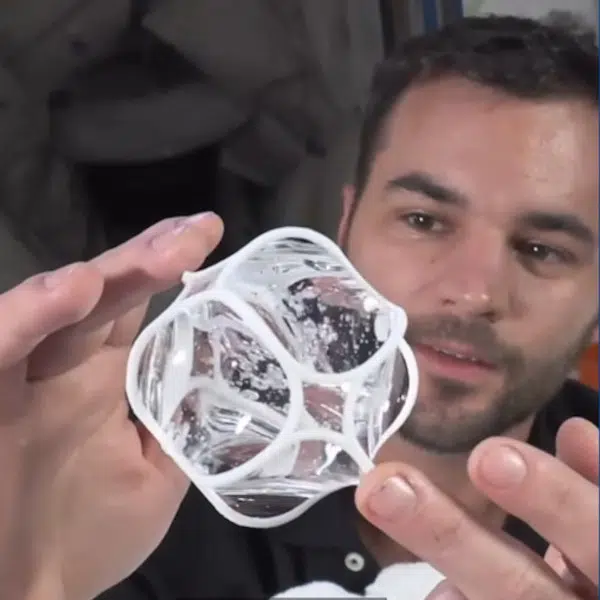
We all know that by their very definition, GIFs are silent. So why is it that people are hearing this GIF created by HappyToast. Originally made in 2008, it's been making the rounds again after Dr. Lisa DeBruine from the University of Glasgow's Institute of Neuroscience & Psychology started inquiring about why many people think they can hear the GIF.
Does anyone in visual perception know why you can hear this gif? pic.twitter.com/mcT22Lzfkp
— Lisa DeBruine ️ (@lisadebruine) December 2, 2017
In fact, she put up a poll that received over 300,000 responses and it turns out that almost 70% of those polled swore they heard a thudding sound. So what is the scientific explanation? For one, our mind has the ability to play all sorts of tricks on us. Remember this image of “red” strawberries that didn't actually include any red pixels? That particular illusion is a test of color constancy, but here we're looking at something different.
What do you experience when you watch this gif?
— Lisa DeBruine ️ (@lisadebruine) December 3, 2017
Christopher Fassnidge, a doctoral candidate in psychology at London's City University jumped in with an explanation. It turns out his lab is researching this type of phenomenon, calling it “visual ear.” A subtle form of synesthesia—when one sense triggers another—it's not as uncommon as you think for people to hear moving objects when they are silent.
The thump is almost entirely in the shake, if you crop out the pylons themselves you can still hear it. They just give it height. pic.twitter.com/3LZK1g24yZ
— HappyToast ★ (@IamHappyToast) December 4, 2017
In fact, many Twitter users, including Happy Toast, correctly deduced that the camera shake contributed greatly to their perception of sound in the GIF. It's actually called Visually-Evoked Auditory Response, or vEAR. “We are constantly surrounded by movements that make a sound, whether they are footsteps as people walk, lip movements while they talk, a ball bouncing in the playground, or the crash as we drop a glass,” Fassnidge explains. “There is some evidence to suggest that synaesthetic pairings are, to some extent, learnt during infancy. I might assume I am hearing the footsteps of a person walking on the other side of the street, when really the sound exists only in my mind.”
I've tracked down a copy of the pylons as they appeared in The Wrong Door – No ground shake and therefore no perceived noise! @lisadebruine pic.twitter.com/KzHw2crPlR
— HappyToast ★ (@IamHappyToast) December 7, 2017
Research at Fassnidge's lab suggests that up to 20% of people experience vEAR, much higher than the 2% to 4% who experience synesthesia. Most times, we may not even be aware of it, which is what makes the “noisy GIF” so interesting. In this case, it's impossible to ignore and there's actually an entire subreddit dedicated to these noisy GIFs.
7 year old son’s report on skipping pylon: “I can’t hear it, but my body can feel it”
— Jonathan Toolan (@toolan) December 3, 2017
Interestingly, some people not only hear a thumping noise, but actually feel the shake. This triggering of a different sense could be related to the brain predicting what is expected next and triggering the appropriate physical response.
Look into Correlated neuronal activity. The brain is “expecting/predicting” what is coming visually and then fires a version of what it expects across the relevant senses. Also explains why some might “feel” a physical shake https://t.co/erpiCiv5hX
— Andrew Kemendo (@AndrewKemendo) December 3, 2017
So why is it some people hear the thump, some people feel it, and others simply see a silent gif? For Fassnidge, it all comes down to the individual. “What determines who experiences vEAR and how intensely is probably individual differences in how our brain is wired.”
Funnily enough, even the creator of the gif isn't sure whether he hears it or not. “I hadn't really thought about the sense of a sound until I saw Lisa DeBruine's posts,” HappyToast shares with My Modern Met. “When I made it, as with a lot of things I animate I tried to give it a sense of weight and I think it's that that people are ‘hearing.' I guess I've always imagined a noise, but still wrestle with whether I ‘hear' it or not.”
Watch this video to learn more about other auditory illusions that can trick your brain.
h/t: [IFL Science, BBC]
My Modern Met granted permission to use GIF by HappyToast.
Related Articles:
If Music Sends Shivers Down Your Spine, You Have a Special Brain
People Were Stumped by This Optical Illusion Dog Until Reddit Figured It Out Together
Perplexing Optical Illusion Stumps the Internet with 12 Disappearing Dots
Puzzling Optical Illusion Makes a Cat in the Desert Look Hollow
Brick Wall Optical Illusion Stumps Thousands of Internet Users






















































































